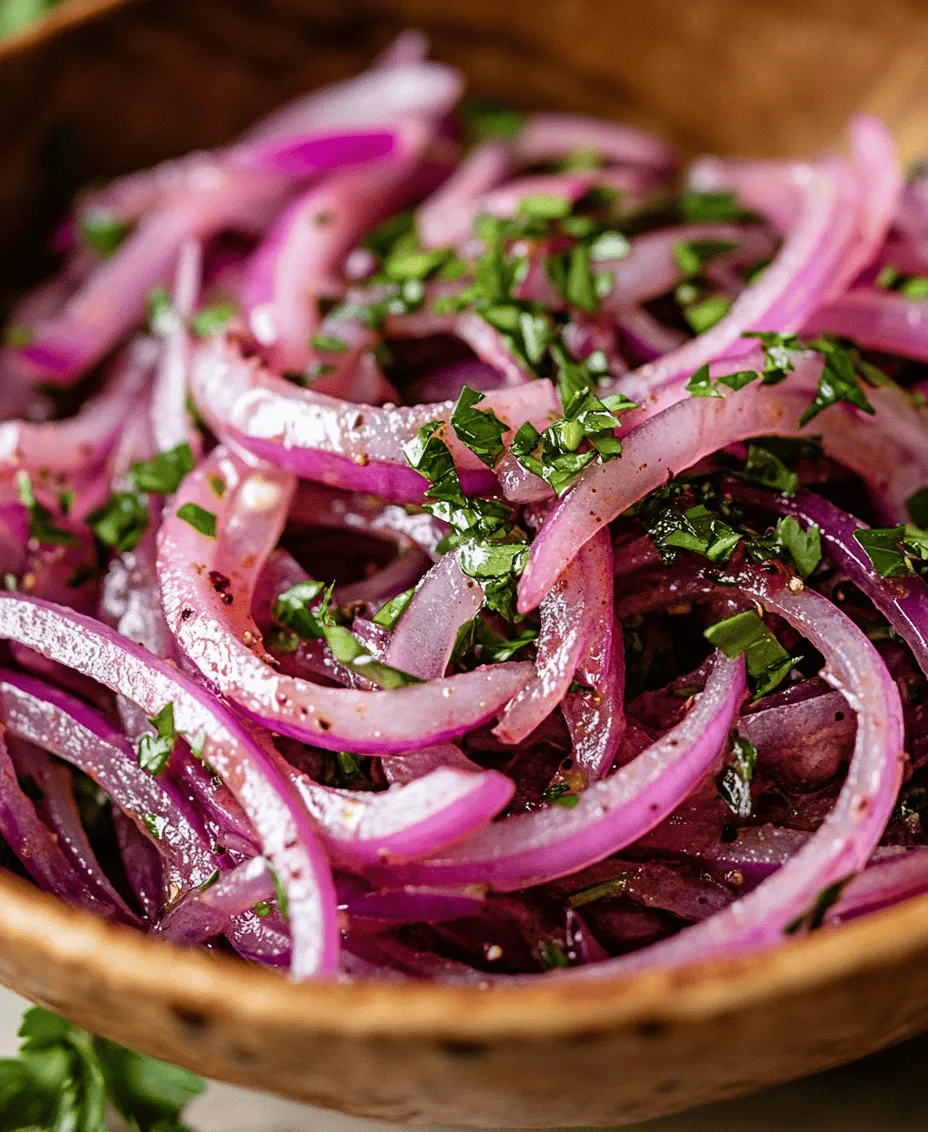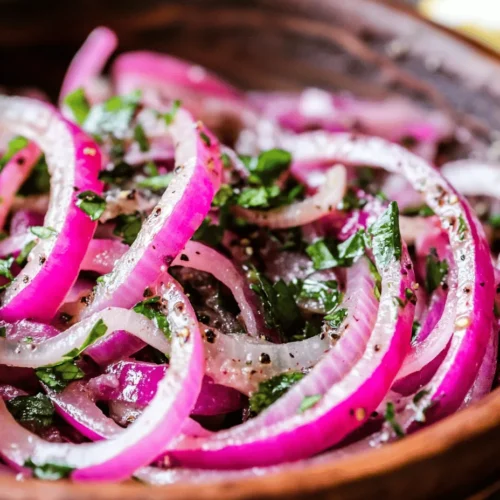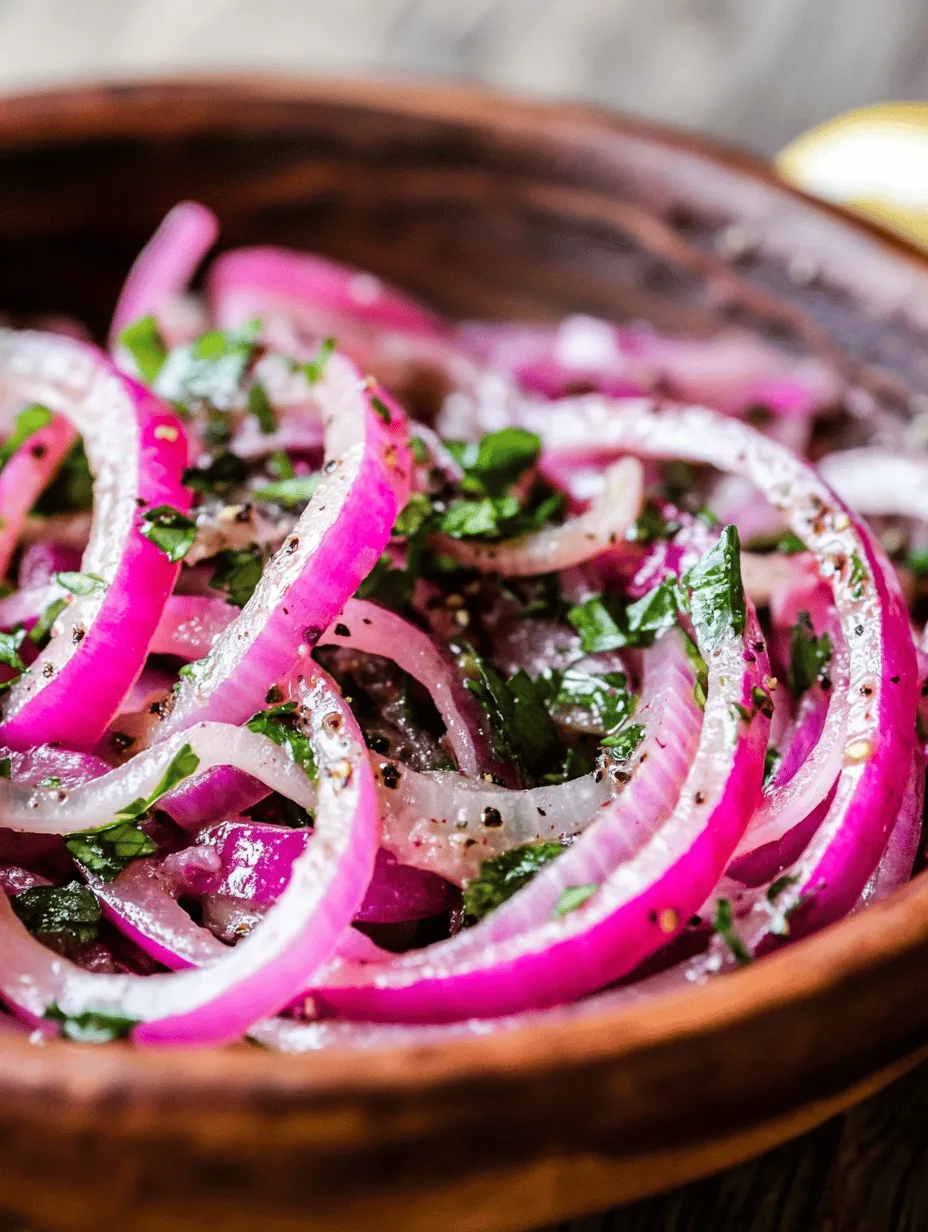Introduction
Zesty Sumac Onions is a vibrant dish that brings a burst of flavor and brightness to any table. Rooted in Middle Eastern cuisine, this dish exemplifies how simple ingredients can create unparalleled taste experiences. The use of sumac, a tangy spice made from the dried berries of the sumac plant, elevates the humble onion to new heights. This recipe not only showcases the unique characteristics of sumac but also emphasizes the importance of incorporating fresh ingredients into our everyday meals. As more people seek to explore diverse flavors and healthy cooking options, Zesty Sumac Onions stands out as a fresh and zesty addition to any culinary repertoire.
Sumac has a distinct tartness, reminiscent of lemon, yet it offers a deeper, earthier flavor that enhances the overall taste profile of dishes. In many traditional Middle Eastern recipes, sumac serves as a key seasoning, adding a refreshing brightness that complements grilled meats, salads, and vegetables. By using sumac in our onion preparation, we can harness its unique flavor to create a zesty topping or side dish that can transform even the simplest of meals into something extraordinary.
The beauty of fresh ingredients cannot be overstated. Incorporating seasonal produce not only enhances flavor but also promotes health and well-being. Fresh ingredients, like onions and sumac, are packed with nutrients and bring vibrant colors to our plates. As we delve into this recipe, we will explore the role of each ingredient and how they come together to create a dish that is as delightful to the palate as it is to the eye.
Understanding Sumac: A Flavorful Spice
Sumac is a spice derived from the dried and ground berries of the sumac plant, which belongs to the Anacardiaceae family. Its flavor profile is unique, characterized by a tangy, lemon-like taste that adds brightness to a variety of dishes. The vibrant red to purple color of sumac makes it not only a flavorful addition but also a visually appealing one, enhancing the overall presentation of meals.
Originating from the Mediterranean region and parts of the Middle East, sumac has been used for centuries in various culinary traditions. It is particularly prominent in Middle Eastern cuisines, where it is often sprinkled over salads, rice dishes, and grilled meats. Its cultural significance extends beyond flavor; sumac has historical roots in trade and culinary practices that have shaped regional diets for generations.
Beyond its culinary uses, sumac is also celebrated for its health benefits. It is rich in antioxidants, which help combat oxidative stress in the body. Sumac has anti-inflammatory properties and has been associated with improved digestion and heart health. By incorporating sumac into your cooking, you’re not only enhancing flavor but also contributing to your overall health and wellness.
The Role of Onions in Cooking
Onions are a staple ingredient found in kitchens around the world. Their versatility is unmatched, serving as a foundational flavor in countless dishes. There are several varieties of onions, each with its unique flavor profile. For instance, yellow onions are the most common and provide a sweet, robust flavor when cooked. Red onions are milder, with a slightly sweet taste and vibrant color, making them perfect for salads and garnishes. White onions are sharp and pungent, often used in salsas and fresh preparations. Each type of onion can bring a different depth to your dishes, allowing for creativity in cooking.
Nutritionally, onions are a powerhouse. They are low in calories and high in vitamins and minerals, including vitamin C, vitamin B6, and manganese. Onions are also rich in flavonoids, particularly quercetin, which has been linked to various health benefits such as reducing inflammation and supporting heart health. Furthermore, their high fiber content aids in digestion, making them a valuable addition to any meal.
Onions enhance dishes in multiple ways: they can add sweetness when caramelized, provide a savory base when sautéed, or add crunch when eaten raw. Their ability to absorb and impart flavors makes them an essential component in many cuisines, and they pair beautifully with a range of ingredients, including herbs, spices, and proteins.
Ingredients Breakdown
To prepare Zesty Sumac Onions, you will need the following ingredients:
1. Onions (preferably red or yellow): The star of the dish, onions provide the base flavor and sweetness. Red onions offer a lovely color and milder taste, while yellow onions give a more robust flavor.
2. Sumac: The key ingredient that brings the zesty element to the dish. Look for high-quality sumac to ensure maximum flavor.
3. Olive Oil: A staple in Mediterranean cooking, olive oil adds richness and helps to soften the onions during cooking. It also enhances the overall flavor profile.
4. Fresh Lemon Juice: A splash of lemon juice brightens the dish, complementing the tanginess of the sumac. It adds a refreshing note that balances the sweetness of the onions.
5. Salt and Pepper: Essential for seasoning, salt enhances the flavors of all ingredients, while freshly cracked black pepper adds a bit of heat and complexity.
6. Optional Ingredients:
– Fresh herbs (such as parsley or mint): Adding fresh herbs can elevate the dish with their aromatic qualities and vibrant colors.
– Chili flakes or fresh chili: For those who enjoy a kick, a sprinkle of chili flakes or slices of fresh chili can introduce heat and depth to the flavor profile.
Each ingredient plays a crucial role in the Zesty Sumac Onions recipe, contributing to its overall taste and appeal. The combination of the tangy sumac, sweet onions, and acidic lemon juice creates a harmonious balance that is both refreshing and satisfying.
Step-by-Step Instructions for Preparing Zesty Sumac Onions
Now that we have explored the background, ingredients, and their significance, let’s dive into the preparation of Zesty Sumac Onions. Follow these detailed step-by-step instructions to create this delectable dish:
1. Prepare the Onions: Start by peeling the onions and slicing them thinly. Depending on your preference, you can slice them into rings or half-moons. Ensure that the slices are even to promote uniform cooking.
2. Sauté the Onions: In a large skillet, heat a couple of tablespoons of olive oil over medium heat. Once the oil is hot, add the sliced onions to the skillet. Sauté them gently, stirring occasionally, until they become translucent and start to soften, about 5-7 minutes. Avoid browning the onions too much, as we want them to maintain their sweetness and tenderness.
3. Season with Sumac: Once the onions are softened, sprinkle a generous amount of sumac over them. The amount can vary based on your taste preference, but a tablespoon is a great starting point. Stir the onions well to ensure that the sumac coats them evenly, allowing its flavor to infuse.
4. Add Lemon Juice: Squeeze fresh lemon juice over the sautéed onions. This will not only enhance the flavors but also help to brighten the dish. Continue to cook for an additional 1-2 minutes, allowing the lemon to meld with the onions and sumac.
5. Season to Taste: Add salt and pepper to taste. Remember, the amount of seasoning can be adjusted based on your personal preference. Taste as you go to ensure the flavors are balanced.
By following these steps, you will create a beautiful and flavorful dish that can be served as a side, topping, or even a salad component. The Zesty Sumac Onions can be served warm or at room temperature, making them a versatile addition to any meal.
As we continue with the rest of the recipe, we will explore tips for achieving the best results, common questions about sumac and onions, and creative ideas for serving this delightful dish. Stay tuned for more culinary insights and inspiration!

Clear, Detailed Instructions on Preparing Zesty Sumac Onions
To prepare Zesty Sumac Onions, you will need to follow a series of steps that ensure maximum flavor and texture. Here’s how to create this delightful dish:
Ingredients
Before diving into the preparation, ensure you have the following ingredients ready:
– 2 large red onions
– 2 tablespoons sumac
– 1/4 cup extra virgin olive oil
– 2 tablespoons fresh lemon juice
– Salt, to taste
– Fresh parsley, chopped (for garnish)
Preparation Steps
1. Slice the Onions: Begin by peeling the red onions and slicing them thinly. Aim for uniform thickness to ensure even marination and flavor absorption. A mandoline slicer can help achieve thin, consistent slices.
2. Mix the Marinade: In a large mixing bowl, combine the sumac, olive oil, lemon juice, and salt. Whisk the ingredients together until they form a well-blended marinade. The sumac will lend a tangy flavor, while the olive oil provides richness and depth.
3. Combine Onions with Marinade: Add the sliced onions to the marinade, ensuring they are well coated. Use your hands to mix gently; this will help to break down the onion fibers slightly and allow them to absorb the marinade more effectively.
4. Marination: Transfer the coated onions into a sealable container or cover the mixing bowl with plastic wrap. Let the onions marinate at room temperature for at least 30 minutes. For best results, marinate them for 1-2 hours in the refrigerator. The longer the marination, the more intense the flavor.
Marination: The Key to Flavor
Marination is a crucial step in this recipe, as it enhances the flavor profile of the onions and softens their sharpness. Here’s why marination is so important:
1. Flavor Absorption: The marinade, enriched with sumac, olive oil, and lemon juice, penetrates the onion slices, transforming their taste from raw and pungent to tangy and savory. Sumac provides a unique tartness that elevates the dish, making the onions a standout component.
2. Texture Improvement: Marinating the onions allows them to soften, making them easier to chew and more palatable. As they sit in the marinade, they also take on a slightly glossy appearance, enhancing their visual appeal.
3. Balancing Flavors: The balance of acidity from the lemon juice, the earthiness of the olive oil, and the tanginess of the sumac creates a harmonious blend that complements various dishes.
Tips for Marination
– Duration: While a minimum of 30 minutes is necessary, aim for at least 1-2 hours for optimal flavor. If time allows, marinating overnight in the refrigerator will yield the best results.
– Temperature: For maximum flavor absorption, let the marinated onions come to room temperature for about 15 minutes before serving. This will revive their vibrant taste.
Ideal Serving Suggestions
Zesty Sumac Onions can be enjoyed in versatile ways, making them a perfect accompaniment to various dishes. Here are some creative serving suggestions:
1. As a Topping: Use the marinated onions as a topping for grilled meats such as chicken, lamb, or fish. The tangy onions will enhance the flavors of the protein while adding a refreshing crunch.
2. In Salads: Toss the onions into salads for added texture and flavor. They pair beautifully with greens like arugula or spinach, along with feta cheese, olives, and cherry tomatoes for a Mediterranean-inspired salad.
3. On Sandwiches and Wraps: Layer the zesty onions in sandwiches or wraps. They work particularly well in falafel wraps or as a topping for veggie burgers, providing a punch of flavor.
4. Flatbreads and Pizzas: Incorporate the marinated onions into homemade flatbreads or pizzas. They can be spread over the base before adding other toppings or used as a finishing touch after baking.
5. Presentation Tips: For gatherings, serve the zesty sumac onions in a stylish bowl garnished with chopped fresh parsley. Pair them with pita bread or crackers for a vibrant appetizer platter.
Health Benefits of Zesty Sumac Onions
This recipe is not only delicious but also boasts several health benefits, thanks to its nutritious ingredients:
1. Nutritional Analysis: A typical serving of Zesty Sumac Onions (1/4 cup) contains approximately:
– Calories: 90
– Carbohydrates: 10g
– Fiber: 2g
– Sugar: 2g
– Fat: 5g
– Protein: 1g
– Vitamin C: 10% of the Daily Value (DV)
– Iron: 4% of the DV
2. Health Benefits of Onions: Onions are rich in antioxidants and anti-inflammatory compounds, which can help reduce the risk of chronic diseases. They are also known for their potential benefits in heart health and may aid in regulating blood sugar levels.
3. Benefits of Sumac: Sumac is packed with antioxidants and offers anti-inflammatory properties. It is often used in Middle Eastern cuisine not only for its flavor but also for its health benefits, including aiding digestion and improving overall gut health.
4. Fit in a Balanced Diet: Zesty Sumac Onions are low in calories and high in flavor, making them a great addition to a balanced diet. They can enhance meals without adding excessive calories, making them ideal for those looking to maintain or lose weight while enjoying flavorful dishes.
Conclusion
Zesty Sumac Onions are a versatile and vibrant addition to any meal, bursting with flavor and health benefits. Their tangy profile and ability to complement various dishes make them a favorite among food enthusiasts.
Not only do they provide a delightful taste experience, but they also contribute to a balanced diet rich in nutrients. Don’t hesitate to experiment with this recipe—adjust the marination time, try different vinegars, or add spices to suit your personal preferences.
Embracing diverse flavors in your cooking can elevate your meals and introduce new culinary adventures. Whether served as a topping, in a salad, or as part of a larger spread, Zesty Sumac Onions are sure to impress your family and friends. Enjoy the journey of flavor exploration with this delightful recipe!



